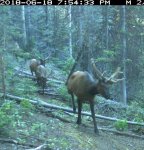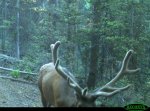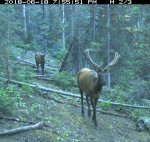idahohikker
WKR
- Joined
- May 10, 2017
- Messages
- 2,160
Best $10 then. Lots of quality content.
Best $10 then. Lots of quality content.



I keep some neon green marabou feathers in a small Ziploc bag tucked inside my bino harness pocket. They are for fly tying. Cheap, extremely light and fuzzy. Tear off a pinch and let it go. You can watch it drift through currents with your binos for quite a while.This has turned out to be an amazing bowl of knowledge guys! I appreciate it much. I'm going to make sure my hunting partner reads this as well. I'd like to know what that spider web wind checker is if you happen to remember let me know. Those are some great pics!

Think of it this way, in general.
1. When you get up in the AM, and hike or drive to your spot, the thermals in GENERAL will be going down slope. As stated above, for how long is the question. If there are any storms, fronts, etc in place, it will mess the thermals up as the wind is overtaking the thermals which will cause unstable winds.
2. When you drive or go to your spot in the evening, it's a good chance the thermals will be coming up slope because everything hasn't cooled off yet. Then, about 2 or so hours before dark, as the shadows overtake some of the draws, valleys, etc. in GENERAL, the thermals will kick in and once again and go down slope. The trick in the evening is you may have to wait longer for the winds to settle before the thermals take over.
3. In general, the darker the slope, draw, drainage (the longer it takes the sun to hit it) the longer you have in the AM to hunt on a steady thermal, and possibly the same in the evening, where you can start working the drainage earlier.
4. Areas above timberline are a totally different beast, and can really be tough as the wind is overtaking the thermals all the time. In my experience, above timberline, or right at it are the hardest areas to hunt due to swirling winds.
5. Sometimes, you will find if a slope is facing the East into a large valley, the thermals will be coming up hard in the AM on the top, but change as you drop down into the shadows.
So, early AM you normally have a couple hours of good steady thermals going down, and again in the evening, 1.5 to 2 hours before dark, thermals going down slope. The rest of the day, well, it can be tricky.
Can you glass from up on that perch? (I am nowhere near Paul's level of knowledge, but...) If you can glass them up from your camp/vantage point as they are moving up towards bedding, then you can move in on them, just don't approach them from directly above. Move in to intercept them from an angle, or put them to bed and wait for the thermals to stabilize and then get set up on them once they are all settled in for their nap.Curious what to do if your camp is above the elk? Do you not hunt the mornings? Or do like Paul and run and gun and worry about the wind once you locate elk? Where we are thinking about camping this fall there is a few finger ridges that we can check, we can get to a few drainages from one spot, but it will most likely be above the elk.



Can you glass from up on that perch? (I am nowhere near Paul's level of knowledge, but...) If you can glass them up from your camp/vantage point as they are moving up towards bedding, then you can move in on them, just don't approach them from directly above. Move in to intercept them from an angle, or put them to bed and wait for the thermals to stabilize and then get set up on them once they are all settled in for their nap.
If you can't glass from there, then locate with your bugle and essentially follow the same plan.
Sent from my SM-G610F using Tapatalk
Can you glass from up on that perch? (I am nowhere near Paul's level of knowledge, but...) If you can glass them up from your camp/vantage point as they are moving up towards bedding, then you can move in on them, just don't approach them from directly above. Move in to intercept them from an angle, or put them to bed and wait for the thermals to stabilize and then get set up on them once they are all settled in for their nap.
If you can't glass from there, then locate with your bugle and essentially follow the same plan.
Sent from my SM-G610F using Tapatalk
Here is the wind checker I'm gonna try this year in some situations
Its not as convenient as micro balloons, but will help in still air


Sent from my SM-G935V using Tapatalk
Send me someThat looks an awful lot like milkweed. I can get just about an unlimited supply of the stuff later this summer in western MN.
Sent from my iPhone using Tapatalk
Send me some
Lol
Sent from my SM-G935V using Tapatalk